DESIGN • BUILD • MAINTAIN

Let’s Hear It
From: Shireen Zia
The award-winning designer on how she got her start
The Future of Equipment
The technology changing the way we landscape
Mythbusting Native Plants Can California native plants fight fire?


Let’s Hear It
From: Shireen Zia
The award-winning designer on how she got her start
The Future of Equipment
The technology changing the way we landscape
Mythbusting Native Plants Can California native plants fight fire?
worth celebrating.


info@mmcite.com www.mmcite.com




08 12 17 23 29 35 37 40 42 45 47
The Future of Equipment
How electrification and robotization are boosting efficiency and combatting the labor shortage
Let’s Hear it From: Shireen Zia
The founder of Ecogardens Landscape Design shares how her passion for gardening took her from stay-at-home mom to award-winning designer
Japanese Garden
K & D Landscaping Inc blends Californian and Japanese influences
Avocado Aesthetics
Max Vedder Land Design tackles a tricky site
The Green Heart of Paris
OnE Site Tour Eiffel by Gustafon Porter + Bowman
Mythbusting Native Plants
Greg Rubin wants to take the heat off native plants
Top Tips for Soil Health
Can healthier soil change the way we landscape?
Spacemaking with Tournesol
From commercial to residential, Tournesol offers stylish, modular products to take your project to the next level
Public Space Reimagined
Smart design transforms shared spaces into places of comfort, creativity, and connection
Beyond Keywords
How AI is changing SEO for landscape businesses
Client Engagement From Anywhere
James Hatfield shares how live video can help landscapers and clients stay connected



“Just in one truck and trailer alone, we save roughly �500 a month."
Tyler Reiter, Florida
Image
Landscape


Like Tyler, users are experiencing the unmatched power Kress delivers for commercial applications, and enjoy lower operating expenses than they did with their gas tools.
And because Kress tools are quieter, crews can start earlier and run later, helping them stay healthier by avoiding the midday heat of summer.


Your local Authorized Kress Dealer can help you seamlessly make the transition away from gas.



Scan this code to find your local Kress dealer.

Eljays44 Ltd, Village Workspaces, 11845 W Olympic Blvd, Los Angeles, CA, 90064
EDITORIAL
Deputy editor - Celia Cummiskey celia.cummiskey@eljays44.com (617) 935-2785
Senior subeditor - Katrina Roy katrina.roy@eljays44.com
Senior designer - Kirsty Turek kirsty.turek@eljays44.com
ADVERTISING
Sales executive - Ollie Finch ollie.finch@eljays44.com
+44 (0) 1903 777579
Event director - Tom Glasby tom.glasby@eljays44.com
+1 210 4481 252
MANAGEMENT
Managing director - Jamie Wilkinson jamie.wilkinson@eljays44.com
+44 (0) 1903 777570
Content director - Nina Mason nina.mason@eljays44.com
+44 (0) 1903 959393
Commercial director - Luke Chaplin luke.chaplin@eljays44.com
+44 (0) 1903 777580
CIRCULATION
Subscription enquiries - Celia Cummiskey celia.cummiskey@eljays44.com (617) 935-2785
Printed by Southwest Offset Printing
Published by Eljays44 Ltd – Connecting Horticulture. Pro Landscaper’s content is available for licensing overseas. Contact jamie.wilkinson@eljays44.com
Pro Landscaper USA is published 12 times per year by Eljays44 Ltd. The 2025 subscription price is $160. Sub scription records are maintained at Eljays44 Ltd, Village Workspaces, 11845 W Olympic Blvd, Los Angeles, CA, 90064. Articles and information contained in this publication are the copyright of Eljays44 Ltd and may not be reproduced in any form without the written permission of the publishers. The publishers cannot accept responsibility for loss of, or damage to, uncommissioned photographs or manuscripts.
Whilst every effort has been made to maintain the integrity of our advertisers, we accept no responsibility for any problem, complaints, or subsequent litigation arising from readers’ responses to advertisements in the magazine. We also wish to emphasize that views expressed by editorial contributors are not necessarily those of the publishers. Reproduction of any part of this magazine is strictly forbidden.

Summer is in full swing! From beach days to fireworks, there’s plenty to keep us busy outside this season. Summer is also a keen reminder of how omnipresent this industry is. It seems like everywhere I look in LA, I see Angelenos enjoying the beautiful landscape design all around us. From citrus trees laden with fruit to permeable pathways lined with agave, this industry shapes how we see and interact with the world around us.

As we begin work on each issue, I’m always astounded by the incredible work and innovations taking place in the world of landscaping. From robotic mowers to soil science, it is a treat to learn from those at the forefront of this wide-ranging industry.
In the August issue of Pro Landscaper USA, you’ll find a product roundup on street furniture and planters, a feature on trends and innovations in equipment for landscapers, and an interview with award-winning landscape designer Shireen Zia of EcoGardens.
As always, we have three stunning portfolios showcasing recent projects both residential and commercial—including a special international project!
This past month, we’ve also enjoyed getting out of the office to attend events like CLCA’s Firescaping presentation in Redondo Beach and the Cactus & Succulent Society of America’s Cactus Show at the inspiring Huntington Gardens in Pasadena. If you’d like Pro Landscaper to cover your industry event, drop us a line at celia.cummiskey@eljays44.com
Happy reading!

You are invited to an exclusive gathering of pool and spa professionals! Join the Pool & Hot Tub Alliance (PHTA) and GENESIS® for the 2025 MasterMind Summit from September 23-25 in Fort Lauderdale, FL, for a celebration of excellence in the industry.
NADRA 2026 Summit & 2025 National+ Deck Competition Awards Gala.
NADRA will hold the 2026 Summit and Awards Gala at the Wyndham Grand Clearwater Beach, FL, from January 7January 9, 2026.
The 16th National+ Deck Competition Awards Gala will be held on January 8th, where we will honor outstanding achievements in deck construction and design.
For those looking to make their trip an extended vacation, additional dates are available from January 1January 12, 2026.
Tickets and sponsorship opportunities coming soon. The 2025 National+ Deck Competition opens this summer!
Join top pool, spa, and hot tub industry leaders for a curated experience designed to inspire big ideas, spark meaningful conversations, and elevate our industry together. This isn’t just a summit—it’s a moment that matters.
• Tackle Big Challenges: Labor, supply chains, consumer expectations—we’re breaking them down, building solutions.
• Learn From the Best: Hear directly from GENESIS® faculty and other trailblazing thought leaders.
• Collaborate and Connect: Engage in roundtables, share real talk with peers, and grow your network.
• Leave Inspired: Walk away with fresh ideas, actionable tools, and the momentum to lead boldly.
Register at phta.org/mastermind
Attendee Registration for Deck Expo is OPEN!
Deck Expo, where deck builders, contractors, and outdoor living professionals gather under one roof to source lasting tools and products.
Connect with like-minded professionals, explore the latest innovations, and learn from the industry’s most influential minds.
Secure Your Pass Early to:
• Source practical tools that make your job easier.
• Explore growth-driving innovation and technology.
• Attend specialized sessions on business and outdoor living.
• Expand your network and find potential partners.
NADRA Builder/Contractor/Remodeler Members receive FREE admission to exhibits.
Make attending official NADRA events easier and save more time for networking by staying with fellow NADRA members at the Resorts World Las Vegas – Hilton Hotel. Multiple lodging locations available.
More information for all events can be found at nadra.org.

AOLP Certification Proves Your Value
In today’s competitive marketplace, it’s not enough to simply say you’re a professional; you need credentials to prove it. The Association of Outdoor Lighting Professionals (AOLP) empowers outdoor lighting experts to rise above the competition through nationally recognized certification programs that demonstrate your skill, reliability, and professionalism.
Clients are looking for professionals they can trust, who not only understand the technical side of outdoor lighting, but who also bring design expertise and real-world experience to every project. AOLP’s certifications provide exactly that reassurance.
Certified Low Voltage Lighting Technician (CLVLT)
Stand out as a true professional with
a certification built to raise the bar. The CLVLT exam brings consistency, credibility, and standards to the outdoor lighting industry. This hands-on certification measures real-world skills and technical knowledge specifically for 12-volt lighting systems.

Showcase your creative talent and design skills with a professional-level certification focused on artistry, layout, and the emotional impact of outdoor lighting design.
Visit AOLP’s website at
aolponline.org/certification to learn more about the process, requirements, and how to get started; or reach out to AOLP’s Certification Associate at certification@aolponline.org.
AOLP offers its certifications in the two days leading up to Illuminate, AOLP’s Annual Conference and Expo. Illuminate ’26 is scheduled to be held February 5 –6, 2026, in Carlsbad, California. For more information, visit this link: aolponline.org/illuminate
The Association of Professional Landscape Designers (APLD) is proud to announce Danilo Maffei, CPLD, FAPLD, as the recipient of the prestigious Harry Schuster Service Award. Named in honor of APLD founding member Harry Schuster— renowned for his enthusiasm, mentorship, and tireless recruitment efforts—this award recognizes individuals who exemplify outstanding service and dedication to the association.
A long-standing advocate for APLD, Maffei has consistently championed the organization and its mission. His contributions are wideranging and impactful, from twice serving as president of the board of directors to playing a leadership role in the organization’s Virtual Chapter.
thinking, passion for landscape design and commitment to mentoring others. Inspiring colleagues and the new
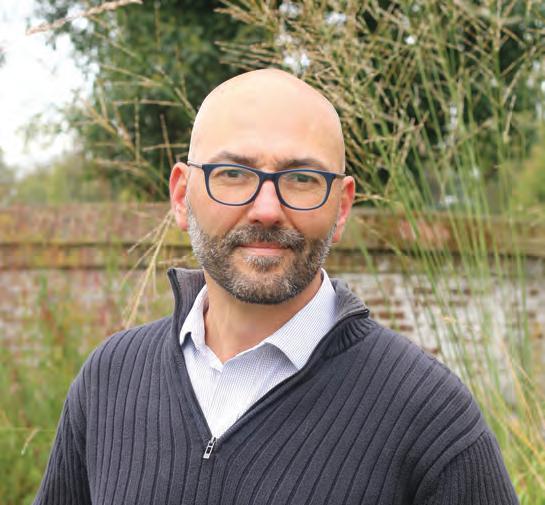
Beyond his leadership, Maffei is also celebrated for his keen critical
generation of landscape designers, Maffei’s efforts leave a lasting imprint on the profession and association alike.
Maffei has also been a driving force behind APLD’s membership and certification efforts. Consistently encouraging participation, promoting the benefits of certification, and working to elevate the profession through active engagement, Maffei’s work embodies the values that the Harry Schuster Service Award was created to honor.
Maffei received the award in October 2024 at APLD’s International Design Conference in Charleston, SC. Richard Rosiello, who presented Maffei with the award, called him the “perfect representation of this award’s purpose.” He said: “We’re deeply appreciative of Danilo’s contributions to APLD and heartily congratulate him on this well-deserved award.”
For more information about APLD’s membership and certification opportunities, visit its website at apld.org
How electrification and robotization are boosting efficiency and combatting the labor shortage

Every landscape contractor wants to be more efficient. Greater efficiency means a crew can save time, take on more work, and increase their earnings. And with labor shortages on the rise, efficiency is more vital than ever.
Pro Landscaper USA sat down with three leading equipment brands to find out what products and innovations are helping contractors save money and work smarter.
“There are two large trends that are at different points in time in the commercial landscape industry— electrification, which is the conversion of gaspowered equipment to cordless or DCpowered, and then robotization, which is reallocating labor from someone standing or sitting on a ZTR to something more productive and profitable, while a robot maintains or mows a lawn,” says Kress’ VP of product development, Todd Zimmerman.
Since 2024, California’s “Green Lawn Care Law” has meant West Coast contractors are increasingly turning to zero-emission options, such as electric and battery-powered equipment. With concerns around noise and pollution, many municipalities are considering similar legislation. Regardless of whether your team is on the West Coast, it is clear battery powered products are here to stay.
Still, many contractors cite concerns over battery length or reliability when switching over to electrified products.
“WITH CONCERNS AROUND NOISE AND POLLUTION, MANY MUNICIPALITIES ARE CONSIDERING SIMILAR LEGISLATION”
In response to feedback from landscapers, Kress developed a longerlasting battery pack.
“The innovative technology that we bring to landscapers is focused on power, constant energy, and cost savings. The innovation in our battery pack means we’re able to utilize more power out of our
pack itself. The technology in the battery reduces the heat or the resistance of each of the cells, so we can get more out of it versus a standard lithium-ion cell,” says Zimmerman. “Reducing the heat build-up means we can charge our Cyber Pack batteries, like our 11-amp CyberSystem battery, in as fast as eight minutes.”
Kress’ Cyber Tank, a DC-to-DC charger, eases worries over access to charging, and with longer-lasting batteries and consistent energy, crews need to invest in fewer batteries.

Toro lists three key areas of focus as a company; alternative power and electrification, smart connected products, and autonomous solutions. At their Center for Technology, Research and Innovation, the Toro team analyzes consumer feedback and seeks to find answers to the real-world problems impacting landscapers.
When the industry voiced a desire for a quieter, electric mower that was equally
as powerful as its gas counterpart, Toro unveiled its Revolution line. Its Z Master Revolution is part of the most powerful line of mowers Toro has created.
With performance comparable to a 38hp gas-powered model, contractors enjoy continuous cutting power for up to nineplus hours with no engine lag. Built on its commercial-grade Z Master 4000 Series frame, the Z Master Revolution pairs all-day battery life with durability, comfort, and Horizon360 connection.
The handheld tools in the Revolution line offer the same guarantees. The 60V Max Revolution Series Handheld Tools are designed with input from professional landscape contractors and built to perform in demanding work conditions. Powered by Toro’s Flex-Force Power System®, the line includes a dual-battery backpack that can hold two 10 Ah batteries.
“Landscapers and contractors are demanding more from their equipment,” says Jordan Hagena, Diamond Mowers’ new product specialist. “Manufacturers are responding by integrating advanced technologies that improve both productivity and safety. Looking ahead, innovations in AI and machine learning are opening the door to unmanned or semi-
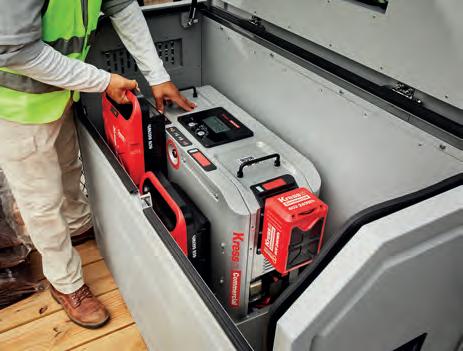
autonomous equipment, which could allow businesses to redeploy labor for maximum efficiency and profitability.”
But Hagena notes there’s more to efficiency than robotic mowers. Landscapers rely on the tools being able to stand up to whatever a project throws at them. “Our product line has evolved directly in response to contractor and landscaper feedback. While Diamond has long been recognized for its customer support, we’ve worked hard over the years to ensure we
also offer the right solutions for the tasks at hand,” says Hagena. “For example, our Brush Cutter Pro X has been an industry leader for years, but it historically required larger skid steers to operate. That posed a challenge for landscapers using more compact equipment. To address this, we introduced the Mini Brush Cutter Pro X, purpose-built for stand-on skid steers. This attachment gives landscapers the ability to get more done with the machines they already have.”
But with many contractors struggling with a shortage of skilled workers, autonomous mowers offer a future where landscapers can outsource time-consuming tasks to robotic helpers. “When landscapers implement robotics to mow the lawn, they don’t have to worry about getting a ZTR out to cut the grass. At that point, they can trim, blow, edge—they can now focus on other things. They can increase their value to that homeowner while they’re on that property,” says Zimmerman. He notes that robotic mowers also offer a ‘cleaner cut’ by only mowing 1/8 of an inch at a time.
“There are study results from the University of Arizona that show when you use a robotic lawn mower, because there

are micronutrients going back down in the soil, the root growth is stronger, which means your grass is greener, which means your grass is thicker, denser. It looks nicer. You don’t have to use as much water.”
With promises of more cutting-edge technologies and products to be unveiled at this year’s Equip Expo in October, keep an eye out for the latest in Toro offerings.
Kress also plans to launch a big debut. “We’re really excited about something we’re referring to as Voyager,” says Zimmerman. “Voyager 40-inch autonomous ZTR. It will allow the landscaper to use labor more efficiently by having the robot mow the residential lawn or the commercial property.”
Kress autonomous mowers offer a near “set it and forget it” experience with one-time mapping, no boundary wires, and full app control. Unlike early models, these systematically cover zones in straight lines for efficient mowing. As Zimmerman notes, you may need to update the map if you add features like a pool, and blades require monthly maintenance. This smart technology delivers reliable, high-quality mowing and keeps raising the bar for autonomous lawn care.
“As the technology comes along and allows landscapers and homeowners to limit the interaction with robots in the yard, I think it becomes more and more viable for them to implement as a landscaper or implement as a homeowner,” Zimmerman says. “I think we’re going to see automation for robotics completely change the way landscapers approach their business today.”


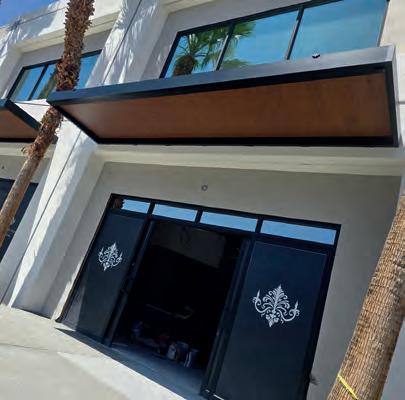




4K Aluminum is the manufacturer and distributor of outdoor patio structures, motorized louvers, privacy walls, awnings, fencing, and gates.
Founder of Ecogardens Landscape Design shares how her passion for gardening took her from stay-at-home mom to award-winning landscape designer
When Shireen Zia, founder of Ecogardens Landscape Design, began taking gardening classes at her local community college, she had no idea she would eventually become a sought-after landscape designer.
Shireen was a stay-at-home mom and passionate about her home garden. Every year, she would overhaul it, experimenting with colors, textures, and new plants.
Growing up in Pakistan, Shireen had been influenced by her mother’s love of gardening. “Lahore is the central part of Pakistan, and it’s surrounded by agriculture. When I was growing up, I saw how my mom used to garden with my dad,” she says.
When Shireen’s mother passed away, gardening became a way to connect with her. Soon, Shireen wanted to learn more—like how to propagate cuttings and why certain plants thrived when others struggled.
“I started taking classes,” says Shireen. “One after the other. When I finished all the classes I could take, my professor said, ‘You’re done with this degree, now what are you going to do?’”
She told him she didn’t know—she’d only been taking the classes to grow her own knowledge. But he encouraged her. He told her she was ready to start designing gardens for clients.
“That’s how I started. Just by exploring what’s out there and what I can learn,” she says.


Shireen was eager for the challenge but wanted to keep sharpening her skills. She started work as an associate under another designer, learning the trade and preparing to eventually take over.
“In the beginning, I had supervision from a very talented designer.


“MY ADVICE TO THE YOUNGER GENERATION WHO WOULD LIKE TO BE IN THE DESIGN WORLD IS TO START OUT WORKING FOR SOMEONE ELSE THAT IS THE BEST WAY TO LEARN AND THE FASTEST WAY”
I learned so much because, before that, I was still learning the scientific names of plants. I knew the common names, but not the scientific names,” she says.
She brought the same dedication from her college classes to her mentorship. She studied plant designs outside restaurants and visited nurseries to test her knowledge of California’s diverse flora. Within a few months, Shireen’s knowledge had grown. She no longer struggled as much with plant names, and her research was paying off.
Shireen credits mentorship with helping to accelerate her career. “My advice to the younger generation who would like to be in the design world is to start out working for someone else. That is the best way to learn and the fastest way,” says Shireen.
But when it came time to take the next leap and find her own clients, Shireen was worried. “When I started out, I had supervision. I was always under an umbrella of protection. So, I learned in a very different way. I’m very fortunate for that,” says Shireen. “But when I started my own business, my biggest challenge was with confidence.”
She worried clients might not trust her. “Because I am new in this field, English is my second language, and at the time I didn’t have any prior work experience as a designer—I had all these thoughts and worries that gave me anxiety.”
But once she made the jump, her fears faded. “When I started talking to people about the plants, I just realized, ‘Hey, I’m ready. I’m ready for this world,’” she says.
Though the design work came easier than expected, Shireen hadn’t anticipated the challenges of running a business. “If I look at myself as a businesswoman, it is clear design is my strongest side. I don’t have any problem working hard, but bookkeeping, business running—all these challenges were my nightmare at the time.”
She says the biggest learning curve was the parts of the industry that tend to go unspoken. “How to build, when to build, how to ask my clients to pay me on time, or how much I should ask for my work… all these challenges were so much bigger than doing the design and giving the final
Previous page: Front lawn in Los Altos, CA, was transformed into a low-water habitat garden; Bringing texture and soft color & thriving in drought-tolerant conditions

product to the clients.”
Over time, Shireen grew more comfortable. “With every challenge, I feel glad that somehow I have overcome it, but there are always new challenges each year.”
Shireen’s experience has taught her how to navigate the business world and rely on her strengths. One of the things her clients love about her? She’s an open book.
“When I was working with my mentor, if she asked me something, I was very honest, and it was on my face. She said, ‘One thing that I like about you is that I can read what you’re thinking,” says Shireen.
Shireen’s clients know they can trust in her work, because she ensures honesty and open communication during the design process. If she’s not sure about a particular choice, she offers alternatives along with pros and cons. This kind of clear dialogue comes from Shireen’s confidence and ability to make clients feel at ease.
And it’s not only Shireen’s clients who rave about her work. Shireen’s designs have won multiple awards over the last few years, including a recent award from the Perennial Plant Association, two APLD awards in 2023 and 2024, and a “Best of Houzz” award in 2022 and 2023.
Her show garden “Modern Rustic Meets Perennial Spring Paradise,” exhibited at the San Francisco Bay Flower and Garden Show, took home Gold, Best in Show, and the American Horticulture Society Award. “The show garden was like I got to be the client and the designer,” she says. “We had five days to finish that garden. It was the fastest installation ever.”
Shireen says the show garden was her

chance to show prospective clients that sustainability can be beautiful.
“The show garden has exactly the same sustainability practices I use in all my projects. That way we could ask our clients to come and take a look at how things can grow and be sustainable. It was a showcase for people to experience the kinds of hydro zones or irrigation system they could have. They could see all the permeable materials that you can use in the garden, and that can look really nice as well.”
Shireen notes that sometimes clients have preconceptions about drought-
resistant plants. “Sometimes people think that drought resistant plants or low water plants won’t look as beautiful. With the show garden, they can come and see that they can have all their colors, and that different kinds of combinations together can give you a wow factor.”
Some recent projects Shireen’s loved?
A Netherlands-inspired permaculture garden using natural materials and California natives.
Sustainability is a huge part of her design process. “The first thing that I always ask my clients is to go to my




website,” she says. “If you like what you see, then I would love to work with you. If you feel like this is not your style, then I would say I won’t be able to design anything with high water plants. I feel it just is not right.”
Wildlife-friendly design is another major consideration.“When you have perennial plants, you have pollinators. Sometimes clients would like to have one kind of pollinator more than the other. Usually they say, ‘no bees.’ But bees will come no matter what. However, in that case I’ll try to have plants that are more bird- and hummingbird-friendly. That is always my style, my strategy, my philosophy for the design,” says Shireen.
Her commitment to sustainability has led her to pursue several accreditations,
including APLD Certified Professional Designer, Qualified ReScape Landscape Designer, QWEL and MWELO Certified, Certified Greywater and Rain Garden Designer, and Certified Laundry to Landscape Designer.
Shireen always utilizes the nonprofit ReScape’s “Eight Principles” in her approach: act local, reduce waste, nurture soil, sequester carbon, save water, conserve energy, protect water and air, and create habitat. These principles promote a regenerative approach to landscaping that works in harmony with the natural world.
Even years into her career, Shireen still has a thirst for knowledge. She visits nurseries weekly for inspiration and to stay up to date on what’s available for clients.
She’s also found attending conferences expands her skill set and opens her eyes to new ideas.
“I just learned that when I started going to the conferences and then meeting with like-minded people, it just opens your vision. You just feel like, ‘Oh, I have never thought about this.’ Or when you go to see gardens designed by other designers, you just learn so much about their strategies— how they group plants or use different materials with one or the other,” she says.
Travel is another huge source of inspiration. “I’m looking forward to my trip this year to Spain to keep learning about the Mediterranean palette. I want to go and see how the plants grow, and how they use the colors with each other.”
Last year, she went on a trip to Joshua Tree National Park to soak up inspiration on how plants naturally grow in California.
Though the quote can seem worn out, Shireen seems to be proof that if you do what you love, you’ll never work a day in your life—and though the journey hasn’t always been easy, it’s always been rewarding.
“Today when I look back on my journey over the last seven years, it’s just amazing. It makes me happy every day,” says Shireen.
to habitat garden; Blue-green palette evokes serenity; Entry path is framed by green-drenched, waterwise landscape; Semi-circular seat wall and firepit nestles into the landscape
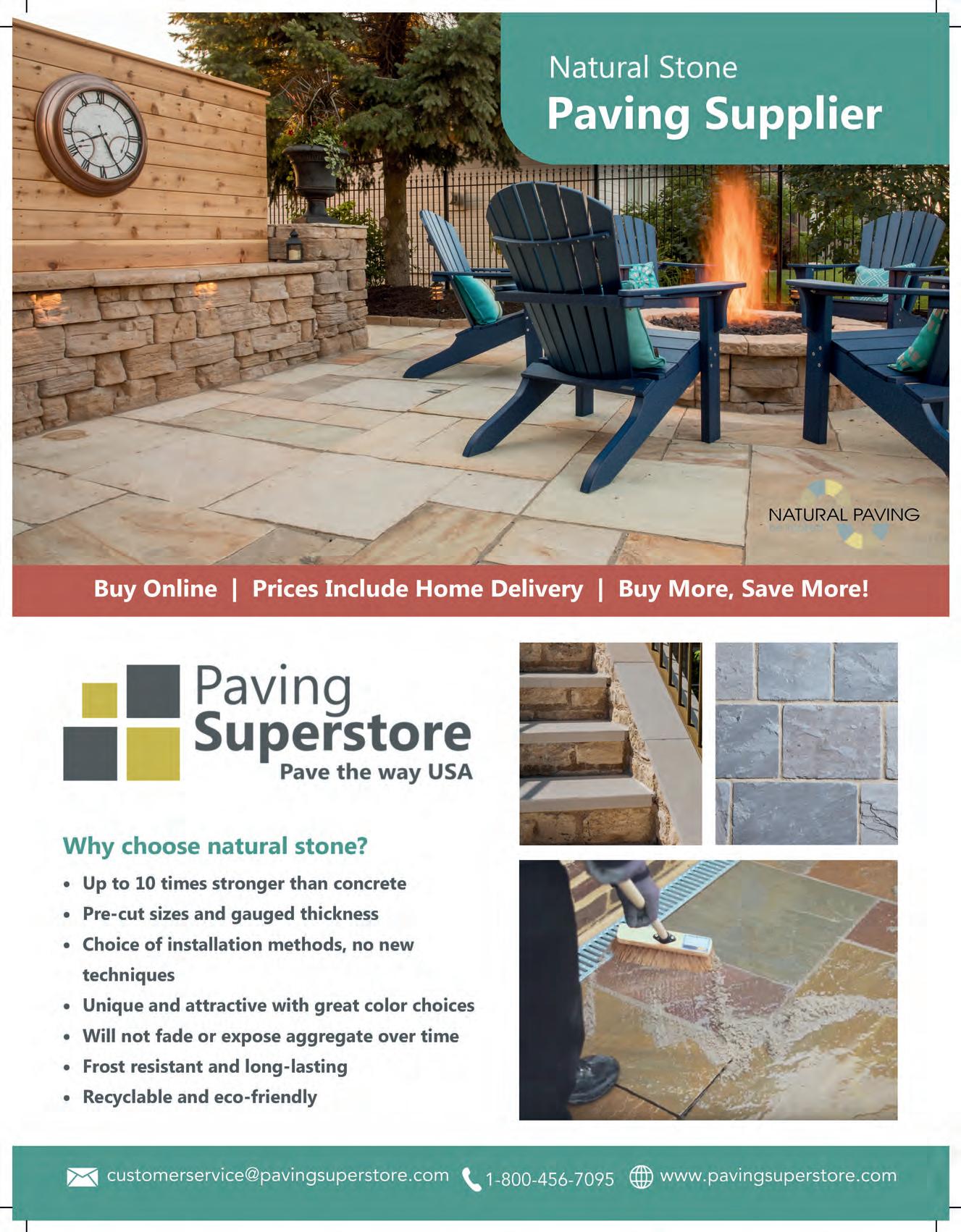

For this Santa Cruz County residence, the client’s brief requested a landscape that reflected the Japanese-inspired architecture of their home while still retaining the natural character of Central California.
According to Justin White, CEO of K&D Landscaping Inc, landscape designer Liz Ryan’s superpower is her ability to work with the client and the space to find the perfect plant match and this project perfectly encapsulates her skills. The plant palette was chosen
carefully in serene shades of green, blending classic Japanese garden species with drought-tolerant Mediterranean varieties. Texture arrives in the form of California natives like Berkeley sedge, and Australian species like grevilleas add pops of color.
Team
Jonathan
Luis
Ramsey Civil Engineering ramseycivilengineering.com
Concrete
Tom Ralston Concrete tomralstonconcrete.com
Water feature
Water and Stone
Natural Landscapes waterandstone.org
Pavers
Peninsula Building Materials pbm1923.com



The team also focused on preserving and highlighting the existing traditional Japanese garden plants like Japanese maples and mugo pines. The combination creates a uniquely layered landscape that is not only beautiful but climateappropriate as well.
The project also utilizes calming neutral shades of warm-toned flagstone, pathways of sand-finish concrete and exposed aggregate, and natural wood accents to accompany the meditative styling of the garden, while Japaneseinspired elements such as mossy boulders, decorative fencing, and subtle asymmetry all work in harmony to strengthen the connection between architecture and landscape.
The unique koi pond is crossed by a custom redwood entry bridge that connects an upgraded existing pagoda to the front entry porch and serves as a visual focal point for the design.
While the result of the garden project is a restful and contemplative landscape,
the process was not always serene. Challenges arose in managing drainage in sensitive areas, navigating a complex low-voltage lighting installation, and decommissioning an existing well.
With the client passionately involved in the process, the scope of the project broadened, and design tweaks were made during the build. However, thanks to a robust design-build method built on a framework of teamwork and clear, ongoing communication—both within the K&D team and with the client—all unexpected challenges were successfully and quickly navigated.
Sustainability was another important consideration during the design process. Goats were used to naturally clear invasive weeds along the perimeter of the property, reducing the need for mechanical or chemical intervention. Hardscape areas were also designed with permeable materials where possible to promote healthy drainage and limit runoff.


K&D’s goal was not only to design a landscape that complemented the residence’s Japanese-Mediterranean fusion architecture, but also one that was water-wise, lowmaintenance, and created a strong sense of place and visual harmony. From the koi pond to the Japanese maples, every detail of the project was carefully considered; the new elements work in tandem with the original specimens, and together the landscape comes alive, transporting visitors to a setting both familiar and distinct.

K&D Landscaping is a trusted, family-owned landscape design and construction firm based in Watsonville, CA, serving residential and commercial clients across Santa Cruz County. Known for its sustainable, water-wise solutions and attention to detail, it specializes in custom outdoor spaces that blend functionality with natural beauty. With a strong local reputation, K&D delivers expert craftsmanship, clear communication, and reliable service from concept to completion. kndlandscaping.com






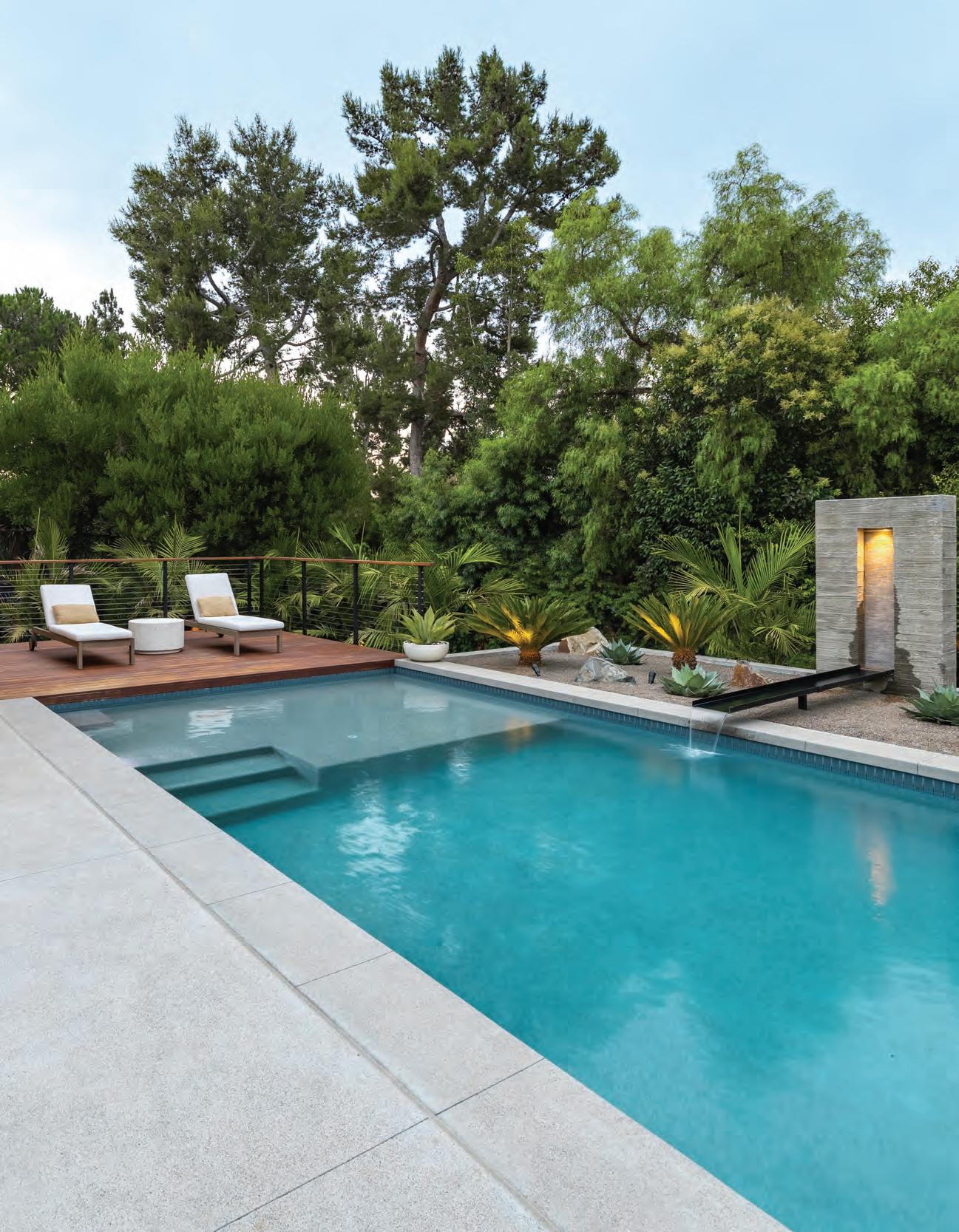
Pool builder
Black Rock Pools blackrockpools.com
Landscape contractor
Rivers Landscape riverslandscape.com

a request for a pool on their sloped yard. They wanted to create usable space for gathering around the pool but weren’t sure how to accomplish this feat given the difficulties of the site.
While some may have been intimidated by the sloped yard, Max Vedder Land Design imagined it as a key feature of the design. The pool was used as a retaining wall, and the raised pool bond beam allowed the team to backfill soil and bring the grade up between the residence and the pool.
This multi-level approach helped to create a seating area with walkways and planters overflowing with textures and shades of green. On the far end of the pool where the team wanted to avoid a large retaining wall, they created an IPE deck with inset lighting for decoration and safety at night. This allowed the slope to pass underneath undisturbed while also offering a space for lounge chairs level with the pool deck. What had once been an unusable slope was transformed into an area for swimming, playing, and resting.




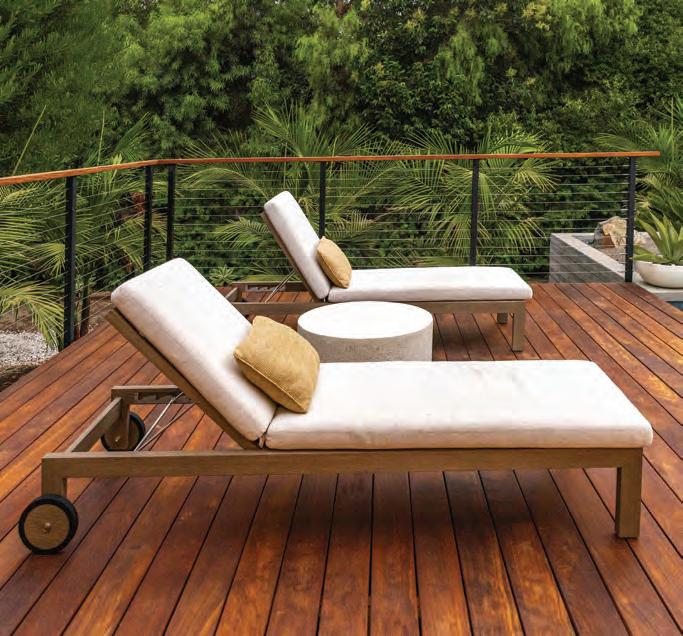
Another key feature of the site was a large avocado tree centered in the yard. The clients were undecided on whether the tree should be removed to make room for the pool. But Max Vedder thought that the shape and age of the avocado tree was too special to remove. Instead, he designed the pool and water feature to wrap around the avocado tree, so that it became the focal point of the design.
To avoid overwhelming the space and to allow the carefully chosen hardscape materials to stand out, a pared-down plant list was used. The team used Agave ovatifolia, Archontophoenix alexandrae, and Lomandra ‘Platinum Beauty’. Sago palms, dragon trees, giant birds of paradise, and a variety of strongly textured subtropical plants added vibrant visual interest and the sense of being in a secluded retreat.
The majority of the softscaping was replanted from another of Max Vedder’s clients that were demoing their full yard. They were able to save and replant large sago palms, whales tail agaves, and several king palms. This, in combination with the low water use plants, made for an extremely sustainable project that was
able to recycle and reuse materials to create a stunning final result. This project exemplifies the best kind of design—one that takes an underutilized space and gives it a new life, encouraging its caretakers to enjoy the outside, to relax with friends, and make memories along the way.
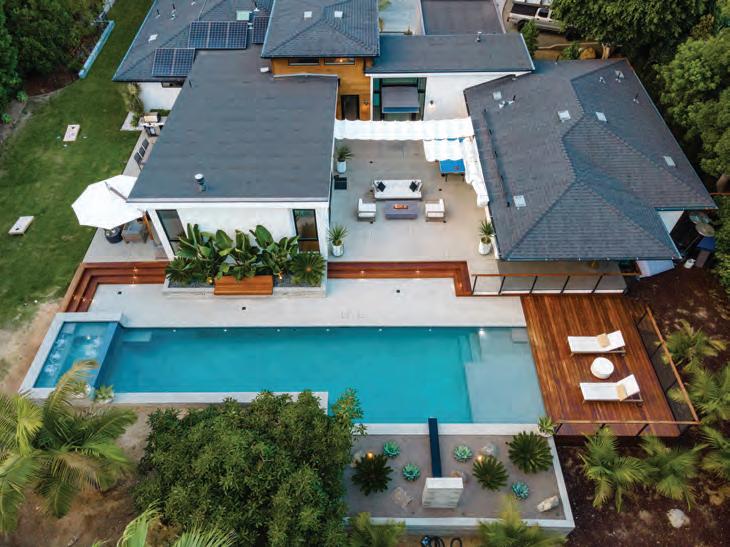

Max Vedder Land Design is a 3-person landscape design studio located in Encinitas CA. They focus on a nuanced approach to modern design with a emphasis on site, textured and natural materials, and layered planting. maxvedder.com



GUSTAFSON PORTER + BOWMAN
ONE SITE TOUR EIFFEL

PROJECT DETAILS
Build time
Since its construction in 1889 for the Exposition Universelle (World’s Fair) held in Paris to commemorate the 100th anniversary of the French Revolution, the Eiffel Tower has undeniably become one of the world’s most iconic landmarks.
At 330 meters tall, it was the tallest man-made structure in the world at
the time of its construction, until the Chrysler Building in New York was completed in 1930. It was originally intended to be dismantled after 20 years but was saved in part due to its usefulness as a radiotelegraph station. Over time it became a beloved symbol of Paris—nowadays around 30 million people visit the Eiffel Tower every year,

with seven million of them ascending the monument for soaring views of the city of love.
The tower’s surrounding site is a victim of its own popularity, issues of overcrowding, impaired accessibility, lack of service, and overwhelmed gardens have in recent years impeded the experience of visitors to the Eiffel Tower and its encompassing landscape.
In May 2018, Gustafson Porter + Bowman and three other teams were shortlisted from 42 entries, all tasked with presenting a re-imagined landscape for the Eiffel Tower site. Titled ‘Site Tour Eiffel’, the international competition sought designs that would respond to the rubric—discover, approach, visit—and deliver a landscape that aligns with the
City’s vision for a resilient, inclusive and environmentally-oriented future.
Gustafson Porter + Bowman’s ‘OnE’ winning design showcases a unified central axis that celebrates the Tower as the central point between the Palais de Chaillot at the Place du Trocadéro and the École Militaire at the Place Joffre. This backbone creates a readable landscape of re-greened spaces: an amphitheater at the Trocadéro, extended public space at the Varsovie Fountains, the reincarnation of Pont d’Iéna as a green bridge, the creation of two new squares at either end of the bridge, a planted landscape beneath the Eiffel Tower and raised lawns for the Champ de Mars.
New views of the tower have been

established alongside points of interest from which to enjoy the site. The central axis ‘landscape of power’ serves to focus the sense of perspective of the Tower from both ends of the site. Overlaying this is a second landscape, one that recalls the French ‘picturesque’ style and its history of gardens as places of artistic experimentation and an increase in biodiversity. The human scale is prioritized, investing unique identities into the spaces. Intimate garden spaces frame the central axis with a rich mix of ornamental and native planting allowing space for temporary events and installations.
The first phase, which was completed in March 2024, is the historical landscape around the Fontaine de Varsovie and

Main contractor (civil) Cochery
Main contractor (landscape) Terideal Mabillon terideal.fr
Subcontractor (planting) Universal Paysage universal-paysage.fr
Subcontractor (irrigation) Terideal Energie terideal.fr
Limestone seats and paving slabs Calminia Pierres Naturelles calminia.com
Granit kerbs/cobblestones Centre de maintenance et d’approvisionnement (CMA) of Paris (Bonneuil)
Granite elements (Gris Castelo / Blanc Cristal) Lahaye granits lahaye-granits.com
Poured concrete slabs CEMEX cemex.com/en
Metal edging Urbencéa urbencea.com
Bound gravel Société Paridu Letourneur DTE Ile-de-France/Normandiev Topsoil Richard et Fils richard-fils.ch

Compost and mulch
Bio Yvelynes Services bioyvelines.fr
Sand
Fibersoil fibersoil.eu
Trees
Chauviré Tree Nursery chauvire.fr
Ebben et Willaert ebben.nl/fr
Turf
Les gazons de Fontainebleau gazonsdefontainebleau.fr
Seeds
Barenbrug barenbrug.fr
Tree protection
Novagreen novagreen.fr
Rootball anchor system
Ancrest ancrest.com/fr
Irrigation Hunter hunterirrigation.com
Fencing Picardie Métallerie Services picardie-metallerie-service.fr
reinforces the architectural heritage of one of the most iconic landscapes of the 20th Century. The renovation, which is part of a wider plan to remove vehicles between Trocadéro and the Iéna bridge, intends to enhance the experiences of the millions of people that visit the Gardens of Trocadéro to view the Eiffel Tower each year. Over 4000m2 of sloped lawns on either side of the fountain have been returfed and
Previous page: View from Fountain of Varsovie ©Hervé Piraud
Current page left to right: Landscape of Fountain of Varsovie ©Hervé Piraud; Aerial view of the Eiffel Tower site ©Lotoarchilab; Newly planted terraces surrounding the Fountain of Varsovie ©Hervé Piraud
Lead designer and landscape architect
(mandataire)
Gustafson Porter + Bowman
Civil engineers
Ma-Geo
Urban design
Sathy
Mobility
Devillers et Associés
Architect Chartier Corbasson
Heritage architect
Atelier Monchecourt
Structural engineers
Bollinger + Grohmann
MEP
Inex Sas
Cost Consultant
Vpeas
Security Cronos
Signage and urban furniture
Saguez
Area 17
Brichet Ziegler
Art and culture
Manifesto
Lighting
8’18
Financial planning
Deloitte
Accessibility and inclusivity
Burdus
Local landscape architect
ALP
Acoustics
Avel
Event specialist
Duck Sceno
Traffic
CDVIA
Pedestrian movement Movement Strategies
Sociology and urbanism
Alain Bourdin
Geotechnical
SEMOFI
Construction management
Planète Management
Soil expert
Sol Paysage
new linear limestone benches at the bottom and the top of the slope provide seating for visitors and protect the historical lawns. The pedestrian promenades have been resurfaced, and the adjacent terraces have been planted with over 15,000 new shrubs and perennials. Twenty-six new cherry trees have been planted either side of the fountain reinforcing the perspective of the Eiffel Tower, and new lighting masts line the walkway with cast glass globes which have been fitted with sustainable LED sources, breathing new life into the space and modernizing the area with respect for the existing aesthetic.
The completion of this initial sector marks the first phase of the wider landscape project, which is currently ongoing following the completion of the Paris Olympics in the autumn of 2024. The next stages include goals to regreen the city, enhance biodiversity and reduce pollution, and will also include the pedestrianization of the Place de Varsovie and the Pont d’Iéna, together with the reduction of traffic lanes and the addition of shrub and perennial planting along the Quai Branly.


Gustafson Porter + Bowman is an international awardwinning landscape architecture practice based in London. It has a team of landscape architects, architects and urban designers led by six partners. Over its 27-year history, it has sought to push the boundaries of what constitutes the field of landscape design. It is passionate about its work, with a strong commitment to achieving the best possible outcome for its clients, the environment and the local community.
gp-b.com













































































Greg Rubin has designed over 800 native landscapes in Southern California and is the author of two books on the subject: The Drought-Defying California Garden and The California Native Landscape. But originally, he was an aerospace engineer.
“I started out as an aerospace engineer, and I did that for nine years from the mid-80s to mid-90s. Then I made the very logical transition to a landscape contractor. I tell engineers, there’s hope for all of us. I’m getting a shirt that says ‘recovering engineer’ on the back,” he says, laughing.
“Firescaping” or fire-resistant landscape design has always been a key factor for Rubin, years before the term took over social media.
“Back in the mid-90s, I had a very important mentor, Bert Wilson at Las Pilitas nursery. Not only was he a great native plantsman, but he was also a 14-year CAL FIRE veteran. He taught me the very first thing I should be thinking about is fire.”
Wilson’s lessons about fireprevention and native landscapes
Greg Rubin, author and founder of California’s Own Native Landscape Design, wants to take the heat off native plants
have proven instrumental in how Rubin approaches landscape design.
“He taught me a number of things that have played out pretty much as predicted in actual fires. We’ve been through about 25 fire events now, and knock wood, we haven’t lost a house yet, even when adjacent neighbors’ houses were tragically lost,” Rubin says. “After the Harris fire in 2007, I had two clients on the same street and they were right in the middle of the fire. Both of them called me the next day and said, Rubin, your landscape saved my house.” He argues that for too long native landscapes have either been erroneously blamed for fire events or improperly implemented and maintained.
“People have this misconception that if you plant natives they’re going to spontaneously burst into flames and burn down your house. What is interesting is that the opposite is true,” he says.
“I learned from Bert that what was missing from native landscapes was native ecology. They’re treated as if they’re ornamental. They’re in a suburban location with God knows what kind of amended soils and crud, mixes of different soils, and compaction. Then, we add soil amendments, fertilizer, and water them with drip systems, and wonder why these native plants only live five to 10 years.”
Emulating nature, Rubin says, has made all the difference. “When we started emulating the natural ecology, the

For fire resistant landscapes, water is key. “It’s much less about plant selection than it is about hydration. Plant flammability is a function of hydration typically, and the corollary that it takes so little extra water to hydrate a native plant. They hold on to moisture, even in a fire situation.”
Rubin recommends light, supplemental overhead irrigation rather than drip for native landscapes to mimic the gentle rainfall, fog, and summer thunderstorms of the plant’s natural ecology.
Soon, however, word spread of Rubin and Wilson’s approaches. “Over time, the US Navy heard about our success and attended a couple of my presentations. They awarded us a four-year research grant to look at this phenomenon of fire resistance in native landscapes. I was a co-principal investigator with Dr. John Keeley, one of the world’s foremost fire ecologists. The results of the test pretty much confirmed our approaches. The rate of fire spread was much less for a lightly irrigated, planted native landscape, and this was actually followed very closely by natural Chaparral that had been thinned by 40 to 50%,” Rubin says.
Though science and experience has proven native plants aren’t to blame in the wake of fire events, they’re still too
“THE NUMBER ONE DETERMINING FACTOR WHETHER YOUR HOUSE WAS GOING TO BURN WAS HOW MUCH DEBRIS WAS ON YOUR ROOF”
often treated as the enemy, says Rubin. “The problem is the insurance companies are pushing for complete clearance around structures, and their whole basic assumption is wrong. They’re assuming that these are fuel-driven fires,” he says. “They’re wind driven to an astounding degree, and by removing all the vegetation around your home, now there’s nothing to catch embers, cool embers, and deflect embers. Except your house, which makes a great ember catcher.”
If all vegetation is removed down to bare soil, this creates something called laminar flow, Rubin explains, which can speed up the air as it travels over smooth surfaces.
Defensible space is important Rubin argues, just not in the way the insurance companies prescribe. “For densely packed housing, you want to start your defensible space in the green belt around the community. Instead of planting a typical ice plant which burns, is terrible for erosion control, doesn’t provide any habitat, and does nothing to affect the flow of embers carried by wind, I suggest making Zone Two the green belt around the community and plant it with lightly hydrated native trees, shrubs, and ground cover.”
Rubin suggests also planting down slope with overlap to create a natural fireblock. “These green belts would be incredible
habitat. If they used predominantly evergreen plants, it would look amazingly beautiful, give the area regional identity, use significantly less water, require low maintenance, and be good for erosion control. It might not necessarily stop the fire, but it’s going to serve as effective defensible space and allow firefighters time to get in there and set up a defensible perimeter,” adds Rubin.
Rubin suggests homeowners and contractors think from the structure out rather than the landscape in—meaning they should focus their efforts on home hardening. “We’ve seen during the fires in January that the number one factor determining whether your house was going to burn was how much debris was on your roof. Simply cleaning your roof and your gutters can make a huge difference.”
Greg Rubin is a member of the Association of Professional Landscape Designers and frequently gives presentations sharing his experience. Though the tide may slowly be changing on native plants, Rubin adds that it is still important to fight misconceptions that circulate after a fire event. For more on how to implement Rubin’s strategies, check out “The Drought-Defying California Garden” and “The California Native Landscape”, available from bookstores and Amazon.

Can healthier soil change the way we landscape? Justin Lombard thinks so—and he’s leading the charge
Justin Lombard is an entrepreneur and business development strategist with a passion for soil health and regenerative agriculture. We sat down to discuss new innovations and strategies in soil health, and why now is the time to reframe the conversation around grass.
Why is soil health an important consideration for landscapers?
“The system is more robust when it’s driven naturally. I think that you’re able to solve problems instead of constantly treating symptoms. From a human side, there are health impacts to spraying chemicals, both in the soil and in the environment.”
What are common mistakes you see landscapers making?
“I think the biggest mistake is accepting someone else’s dogma and not being curious and being willing to learn. The tension within the industry right now is that we’ve educated the public to expect a result that is not natural. I mean
specifically the idea that you see greenup long before the temperatures would naturally make that nitrogen available.
It’s hard setting expectations and having these conversations.
I learned from Chip Osborne, from Osborne Organics, about the importance of having conversations with people on the benefits of doing things in a different way, and what it’s going to look like when it’s natural.”
“I THINK THE BIGGEST MISTAKE IS ACCEPTING SOMEONE ELSE’S DOGMA AND NOT BEING CURIOUS AND BEING WILLING TO LEARN. THE TENSION WITHIN THE INDUSTRY RIGHT NOW IS THAT WE’VE EDUCATED THE PUBLIC TO EXPECT A RESULT THAT IS NOT NATURAL”
wanted to see what they could do with their grounds, switching it over from a chemical system to a regenerative system. Soil health was important to them because of how it impacts Florida specific issues like algae blooms. We were able to connect them with Field Logic Agronomy, and a guy named Brian Walker.
Where should landscapers start?
“Look into what is available locally. I think compost is a great place to start. Also understanding how biochar and worm castings can affect your plantings. Those three things can transform a garden without a drop of synthetic chemical.”
What are some projects you’re excited about right now in the soil health space?
“I’ve connected a group I work with called Field Logic Agronomy with a university in southwest Florida called Ave Maria University. It’s a small Catholic school, and I got connected to them through one of the brands that I represent. They really
“Brian is at the forefront of testing and analysis in turf grass systems. He combines that with cutting edge soil remediation tools and inoculants to create truly regenerative green spaces. Ave Maria is completely changing over their systems, and we’re documenting that with tissue and advanced soil testing. Ave Maria is willing to publish these results, and they really want to be a part of a story of charting a new path in Florida.”

Justin is an entrepreneur & business development strategist with a passion for soil health and regenerative agriculture. He’s dedicated to building strong teams and fostering relationships that connect innovative tools, resources, and strategies to the farmers who steward our most valuable resource: soil. He’s empowering the community by driving sustainable practices. rgnbrands.com











Designers from the UK and the USA will be competing for the Ryder Cup of landscaping with their own show gardens.


The Nursery Zone highlights the plants and living material which are at the heart of every project. Here you’ll find a curated selection of top U.S. nurseries showcasing both staple and specialty stock suitable for commercial, municipal, and high-end residential applications.
Celebrating excellence in landscaping design across five categories, the Futurescape USA Awards spotlight standout projects in residential, commercial, and urban development.


An exclusive space with high-value purpose, the VIP Lounge is designed for senior professionals to meet, reflect, and connect in an environment curated for meaningful conversation.
Within this space, the Rising Stars showcase highlights emerging leaders and next-generation professionals who are shaping the future of landscape design, construction, and care.


The Interactive Zone is a hub for expert-led insight, editorial access, and strategic conversation, all delivered in a casual, lounge-style environment.
As demand for lifestyle-driven landscapes grows, the Outdoor Living Zone becomes essential for anyone designing or building multifunctional outdoor spaces.


TFrom commercial to residential, Tournesol elevates every outdoor space rapid growth over the past 10 years while staying true to its core values of quality, sustainability, and service.
ournesol is a leading North American manufacturer of planters, site furnishings, and green façade systems designed to enhance both commercial and residential environments. Though the company began nearly 30 years ago as a container irrigation provider, it has evolved into a design-forward brand known for its modular, sustainable products that bring beauty and functionality to the built environment.
Named after the French word for sunflower, Tournesol has experienced
More recently, Tournesol expanded its portfolio with the addition of Greenscreen®, a premier manufacturer of commercial trellis systems for green façades. This strategic move has further strengthened Tournesol’s position as an innovator in integrated landscape solutions.
“Tournesol products are offered in a variety of material choices and are manufactured in North America. Our

planters and site furnishings—made from aluminum, steel, and thermally modified wood products— are made in Port Orchard, Washington. We produce our lightweight concrete planters and benches in Juárez, Mexico, and we fabricate Greenscreen trellis products in Southern California,” explains Carla Dougher, head of marketing.
Tournesol is particularly well-versed in rooftop applications, a setting that demands specialized expertise. “Rooftops are one of our sweet spots,” says Dougher. “These environments are exposed to sun, wind, and weight restrictions—and we’ve developed products specifically to meet those challenges.”
Tournesol has mastered the balance of form and function on rooftops with its bioretention planters. Designed to filter and manage rainwater runoff, these customizable planters can be seamlessly integrated into most rooftop designs.
“Specifying commercial grade products for ‘resimercial’ sites is something we’re seeing more often. Commercial-quality materials deliver performance and longevity which equates to a better return on investment—creating long-term value and ensuring customer satisfaction,” says Dougher.
during the design phase. We review plans, recommend solutions, and help identify products that deliver the best fit and performance.”
Modular furnishings like the Camino seating collection offer flexibility, style, and function.
“It’s a beautiful bench system featuring integrated lighting in a range of sizes for custom configurations,” notes Dougher. Constructed from powder-coated steel and thermally modified hardwood, Camino exemplifies Tournesol’s designforward thinking.
Tournesol’s feature planters are offered in a wide array of colors, textures and finishes. The new Two-Tone Bolinas Planters, for example, feature dual finishes in sophisticated colorways.
Customers can shop Tournesol products through two platforms. The trade portal is used for commercial project planning and quoting, and a new shop.tournesol. com e-commerce experience provides

“Today’s clients expect high quality, especially when paying for premium products. Our products come with a three-year warranty and our team is just a phone call away. One of our unique strengths is our team of knowledgeable advisors and project managers,” Dougher adds. “We regularly collaborate with landscape architects and contractors
fast, direct purchases.
“Shop Tournesol is great for lastminute additions, residential or small commercial projects,” Dougher explains. “It’s designed for speed and convenience.” Many of the online purchases are for retail storefronts, hospitality spaces and outdoor plazas, where a few high-impact feature planters help to elevate the space.
Tournesol supports the design community with free material samples, nationwide rep coverage, as well as educational resources.
“We love connecting with landscape contractors and design firms,” says Dougher. “Our reps are located across the US, and are always available to present our product lines in person.”
The company offers AIA-approved CEU courses via AEC Daily too, with highly rated content on topics like green façades and rooftop design. Design tools such as downloadable models and planning guides are readily available to support project workflows. Tournesol has also been an active supporter and sponsor of the ASLA organization at both the local and national level.
As Tournesol continues to grow, so does its commitment to elevating outdoor environments—through innovative products, trusted expertise, and a vision rooted in sustainability and service. tournesol.com

Mmcitè Flaneur
In the street, like at home. The cohesive Flaneur outdoor furniture collection is a response to the changing character of public space. To its newfound relaxation, trust, increased safety, and the growing tendency to feel at ease in it, as if in the privacy of one’s own garden. mmcite.com/en/flaneur


Smart design transforms shared spaces into places of comfort, creativity, and human connection
Streetlife
Rough&Ready Tree Isles
Tree Isles are planters composed of Corten steel elements, featuring a Rough&Ready seating edge. The hardwood beams are positioned radially, creating an effective, built-in anti-skate solution. These stand-alone units can be placed on a concrete deck or embedded in the ground; no additional foundation required. The seating edge is seamlessly integrated into the steel structure. Using Streetlife’s patented Streetlock® fix-and-replace system, beams can be quickly replaced if damaged, ensuring long-term functionality. streetlife.com


Mmcitè Linfa
Visually light, exceptionally strong. Linfa is a minimalist bench that defies its visual lightness with remarkable stability and strength. Whether making a statement in urban squares, harmonizing with the natural beauty of a blooming park, multiplying at a train station, or standing alone in a library, Linfa effortlessly adapts to any setting.
mmcite.com/en/linfa
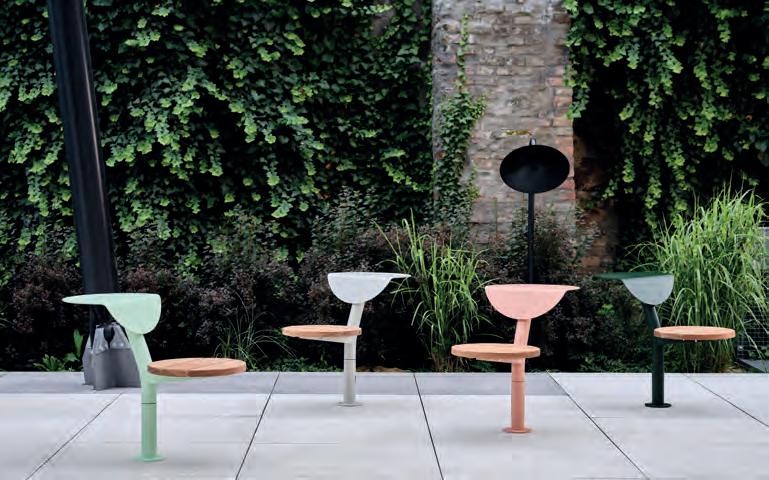
Mmcitè Morse Dot
A random turn for a random encounter. The Morse collection is expanded with the stand-alone element Morse Dot. Experience the playful swivel variant of public space. The single steel leg with a wood seat effortlessly transforms into a backrest and table in one.
mmcite.com/en/morse-dot

A sculptural statement designed to transform any space. Handcrafted in the British Isles, each planter is formed from eco-crete and natural materials. No two pieces are the same; over time, each develops its own distinctive weathered patina, enhancing its charm.
Medea elevates residential gardens, commercial courtyards, and interior spaces. As one of the largest artisan planters in the world, it’s made to stand alone as a focal point or to complement a curated landscape. Every planter is thrown and shaped by hand.
torcpots.com/our-collection/p/medea
Starting with our iconic Wilshire round planters, the twotone finish brings refined contrast and quiet elegance to their sculptural form. Lightweight GFRC planters in textured Chalk Sandblast are finished in one of six Natural Sand colors, enhancing their sculptural quality and dimensional presence. tournesol.com/twotone

Escofet Gather
Designed by Foster + Partners Industrial Design, Gather is a modular seating system in which organic forms can be combined in configurations ranging from enclosed pocket spaces, to straight benches, to seating around green islands. landscapeforms.com/products/gather


Escofet
Petra
Designed by Escofet_lab, Petra includes three monolithic concrete forms inspired by smoothly rounded river rocks and intended to serve as communal seats and meeting points. landscapeforms.com/products/petra

The way customers find landscape contractors is undergoing significant transformation. As artificial intelligence reshapes search behavior, established contractors who built their businesses on traditional SEO strategies must adapt or risk losing ground to more digitally agile competitors.
The shift is already here
People who traditionally searched only on Google are now using platforms like ChatGPT and other AI models to make decisions about which companies to get quotes from. When planning a major backyard investment, homeowners want to ensure they’re choosing someone trustworthy, reliable, and experienced with their specific project type. This change demands a fundamental rethinking of how we present our businesses online. AI models are pulling information from multiple sources beyond Google search results. These AI systems reference various platforms when making contractor recommendations, which means your information must be current and comprehensive across every directory. Critical platforms you cannot ignore include Bing Places, which easily syncs with your Google Business Profile. Even if you have no intention of paying for Yelp advertising, you still need a complete free profile there. Houzz has emerged as another platform that AI models frequently reference for contractor recommendations.
The most crucial element for AI visibility is reviews. This is nonnegotiable. At a minimum, you must implement a systematic approach to collecting customer reviews. More importantly, encourage customers to
upload photos and videos of your completed projects. For every project you complete, secure a testimonial from the client along with comprehensive photo and video documentation.
Transform your content strategy
Don’t maintain a simple project gallery with static photos. Create individual pages for each completed project that tell the complete story. Include detailed descriptions, embed videos, and showcase the transformation process. Project gallery pages are becoming the second most visited sections of contractor websites because customers thoroughly research your past work.
Social media distribution amplifies this content’s reach. Post project videos across all platforms and create YouTube walkthroughs of completed installations. This visual content serves dual purposes: engaging potential customers and providing AI systems with rich data about your capabilities.
The path forward requires action
First, audit your online presence across all directories that AI models reference, ensuring consistent business information. Second, implement systematic review collection emphasizing detailed feedback. Third, join local chambers of commerce and industry organizations for additional credibility signals.
Consider using digital press releases to announce major projects or business milestones. These create extra online mentions that AI systems can reference when evaluating your business authority and expertise. Start monitoring how AI tools reference your business. Search “find the best landscaper in San Diego” using ChatGPT to understand how you’re positioned or if you’re mentioned. The contractors who thrive in this AI-driven landscape won’t be those who resist change, but those who embrace it strategically. The transformation is happening now, and your competitive advantage depends on adapting quickly.

Josh Blakeley founded Landscape & Hardscape
Contractor Marketing to help outdoor living professionals thrive. Originally from Australia, he now lives in San Diego with his wife Chelle and son Theo. Drawing on his experience running digital campaigns for industry professionals, he wrote Backyard Empire: The Ultimate Digital Marketing Guide for Outdoor Living Pros. His insights help professionals overcome marketing challenges, attract more leads, and build strong local brands. landscapecontractormarketing.com
































Get involved in our September 2025 issue



Our September issue will spotlight all things hot tubs and saunas—and there are plenty of ways to get involved!

Whether in one of our gorgeous portfolios or the “Meet the Supplier” feature, we’d love to include you in Pro Landscaper USA. Plus, don’t miss out on industry news, business advice op-eds, and more.
Want to see yourself in the magazine? Write to us!

For editorial inquiries: Celia Cummiskey Deputy
editor












For sales inquiries: Ollie Finch Sales


executive

celia.cummiskey@eljays44.com

ollie.finch@eljays44.com




Live video isn’t just for internal use. It’s also a powerful way to involve clients remotely, especially when scheduling in-person visits is challenging. Showing progress via video walkthroughs builds client confidence and keeps communication transparent. By streaming a live site tour or addressing client questions on video, landscapers can meet expectations and approve changes faster, saving time and reducing last-minute surprises. For clients hesitant to visit the site frequently, this approach provides peace of mind and helps build trust.
Despite its many advantages, using live video effectively in landscaping does come with some challenges. Outdoor job sites
often face connectivity issues due to poor cell coverage or unreliable Wi-Fi, which can disrupt video calls. To address this, companies should invest in portable WiFi hotspots or choose video platforms that perform well even in lowbandwidth situations. Additionally, frequent video check-ins can lead to screen fatigue among crews and managers if not managed carefully, so keeping calls brief and focused is essential to avoid unnecessary interruptions.
“RECORDING VIDEO AT RESIDENTIAL SITES REQUIRES CLEAR COMMUNICATION AND CONSENT FROM CLIENTS TO ENSURE THEIR COMFORT AND TRUST”
communication and consent from clients to ensure their comfort and trust. Establishing clear protocols for when and how video is recorded can help protect privacy and maintain strong client relationships. By proactively tackling these challenges, landscaping businesses can integrate live video smoothly into their daily operations and maximize its benefits.
Privacy is another important consideration. Recording video at residential sites requires clear
To get the most out of live video, start by picking the right platform. Choose
software that’s easy to use, works well on mobile devices, and offers features like recording, screen sharing, and even chat for quick follow-ups. Clear communication with your team is just as important. Set expectations around when to use video calls versus other communication methods, and keep those calls brief, focused, and purposeful to respect everyone’s time and avoid video fatigue.
Once the basic structures are in place, companies can begin to integrate live video into their daily tasks. By encouraging crews to display unexpected issues live before abruptly stopping work, teams can enable faster, more accurate problemsolving while minimizing downtime. Also, use video for remote training to demonstrate techniques and review work, making skill-building more interactive and hands-on—even at a distance.
Involve clients with scheduled video walkthroughs to keep them engaged, informed and reduce unnecessary inperson visits. Don’t forget to record key
conversations such as approvals and change orders. These visual records help avoid misunderstandings, ensure accountability, and protect your business in disputes.
As live video tools improve and integrate with job management software, landscapers will gain even more ways to streamline operations, reduce costs and deliver better client service. Smart use of live video empowers small crews and busy managers to stay connected, work smarter, and maintain high standards, even from miles away.
Looking forward, artificial intelligence (AI) features embedded into video platforms will simplify notetaking during calls, create photo and video checklists, as well as analyze footage to detect safety risks or quality issues. Live video is evolving beyond simple communication; it’s becoming an essential tool that drives smarter workflows, boosts accuracy, and transforms how landscaping teams operate every day.
Live video isn’t a silver bullet, but when used strategically, it can become an indispensable part of landscaping operations. It saves time, reduces costly mistakes, supports team development and improves client communication— all crucial in an industry where timing and maintaining quality are everything. Adopting live video is less about technology and more about improving how teams communicate, collaborate and succeed.

James Hatfield is chief revenue officer of LiveSwitch, a leading communications platform that uses instant video to transform how landscaping businesses and other service companies scale their businesses. He is responsible for the customer experience and growth, and has extensive leadership experience with companies ranging from fast-growing startups to Fortune 500 enterprises. liveswitch.com



Pro Landscaper USA asks quick-fire questions to gain a small insight into the people who make up our industry. To take part email celia.cummiskey@eljays44.com



Joseph Barnes
Yellowstone Landscape yellowstonelandscape.com
Other than the US, which country’s landscape inspires you the most? When I see the large-scale public space projects in China, I am always amazed. Their focus on precision and multifunctional spaces, mixing landscape with dense urban environments —it is really something.
Kayla Lujan
You’re on vacation—lounge on the beach or explore a new city?
Well, I’m fortunate to live about 15 minutes from the beach, so I’ll go with checking out a new city.
Best piece of advice?

It’s better to be clear than to be clever. Too many marketers try to be clever, but just end up confusing their audience.
Karaoke song?
I’m not singing it, but I think Sweet Child O’ Mine is always a crowd pleaser.

Down to Earth Landscape & Irrigation dtelandscape.com
Other than the U.S., which country’s landscape inspires you the most?
South America. We travel there every year; the people are incredibly kind and the adventure opportunities are endless. The landscape ranges from breathtaking mountains to lush rainforests, with a huge variety of plants and ecosystems to explore.
Rich Kang
Ruppert Landscapes ruppertlandscape.com
Other than the US, which country’s landscape inspires you the most? Italy—from the beautiful mountains and rolling hills to the coastlines.
You’re on vacation—lounge on the beach or explore a new city?
Explore! I’m 100% the adventure seeker.
Best piece of advice?
Don’t compare yourself to others. You’ll either see them as better and get discouraged, or see yourself as better and become arrogant. Neither mindset leads to growth.

and I love learning the history and trying local restaurants.

You’re on vacation—lounge on the beach or explore a new city? Explore a new city. I can’t sit still for too long
Best piece of advice?
Work hard. Stay humble.
Karaoke song?
Livin’ on a Prayer, Bon Jovi. It’s a classic, and everyone loves to join in on the chorus.
Dream project?
Creating a sustainable, community green space that blends beauty, function, and environmental stewardship—like a public





Dream project?
Anything that’s educational and open to the public, like a botanical garden.
One thing that you think would make the industry better?
More openness to advances in technology. We need more early adopters to help push technology along faster.
Trend you’re tired of?
AI fails. Showcasing where these tools still need to improve isn’t helpful and it


won’t prevent them from becoming an important part of our lives.
Who is playing you in a movie?

I’m a big fan of Matt Damon, but even he couldn’t get people out to see a movie about a marketing director at a commercial landscape company.

Karaoke song?
Queen of the Night, Whitney Houston.
Dream project?
To own and run a campground— with amazing landscape of course!
One thing that would make the industry better?
Investing in talent and training, specifically developing account managers and operations leaders. They’re the backbone of the industry and often the least supported when it comes to training and growth.
park or campus. Something that improves quality of life and connects people to nature, where every landscape decision has a positive impact.
One thing that you think would make the industry better?
Attracting more young talent, especially right out of high school or college. We need to showcase the career paths,

Couldn’t get through the week without…
Outdoor adventure time with my family.
Trend you’re tired of?
Anything TikTok.
Who would play you in a movie?
Amy Schumer.

Couldn’t get through the week without…
Cycling, running or working out— some kind of activity .
innovation, and fulfillment that this industry offers.
Trend you’re tired of?
Voice-activated everything. I’ve gotten into a shouting match with my smart speaker more times than I can count.
Couldn’t get through the week without…
Coffee, working out, and watching my sons play sports. Those three things help me recharge and stay balanced no matter how busy the week gets.




